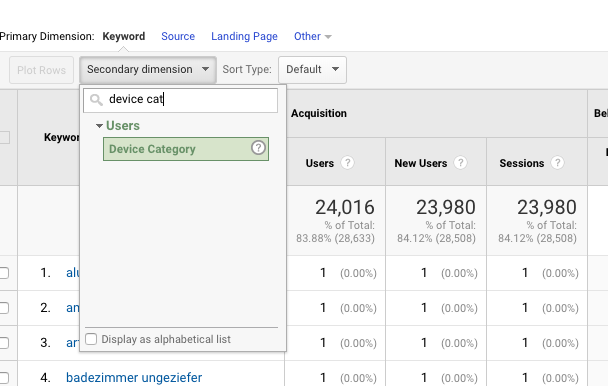Unlock Deeper Insights With Second Measurement in Google Analytics
With the huge expanse of data readily available in Google Analytics, the utilization of additional dimensions can substantially enrich your analytical capacities. These extra layers of data use a nuanced viewpoint that can brighten elaborate information within your primary metrics. By purposefully incorporating second dimensions right into your evaluation, you can uncover valuable understandings that may otherwise stay undiscovered. The capacity to dissect and interpret user behavior with greater precision opens up a realm of opportunities for improving and enhancing methods performance.
Understanding Key Vs. Secondary Dimensions
When assessing data in Google Analytics, it is important to identify between second and key measurements to gain much deeper understandings into individual habits. Main measurements are the primary categories by which you can view your data, such as source/medium, device, or touchdown page. These dimensions give the fundamental structure for organizing and comprehending your information. On the various other hand, second measurements permit you to more study your key measurement data. By including a secondary dimension, you can layer on additional details to your primary measurement, making it possible for a much more granular evaluation. If your primary measurement is the source/medium with which users arrived on your site, adding a second dimension like geographical place can reveal where those users are located geographically. When looking at the primary dimension alone, this included layer of information can help you determine patterns, patterns, or abnormalities that might not have been apparent. Leveraging both second and primary measurements in Google Analytics is vital for detailed information analysis and notified decision-making.
Making Use Of Secondary Dimensions Effectively
Successfully using second dimensions in Google Analytics boosts the deepness and granularity of information analysis, giving useful understandings into user habits and trends. By incorporating secondary measurements alongside key measurements, analysts and marketing professionals can dig deeper right into the specifics of customer interactions on their websites. Secondary dimensions enable customers to sector and filter main measurement data further, using a much more comprehensive view of individual demographics, actions, and interactions. This can be specifically beneficial when trying to understand the effect of certain variables on individual engagement, such as the browsers or gadgets they are making use of, the resources of their web traffic, or their geographic places.
Moreover, second dimensions allow users to compare and contrast various information points within a solitary record, helping with a much more detailed analysis of customer behavior patterns. By leveraging secondary measurements efficiently, businesses can uncover concealed understandings, maximize their advertising and marketing strategies, and improve the overall user experience on their internet sites.
Exploring Typical Secondary Measurement Mixes
To further assess customer behavior and trends in Google Analytics, it is important to check out common combinations of second dimensions. Some usual additional dimension combinations that official website provide beneficial insights consist of examining traffic sources with user areas to comprehend where website site visitors are coming from geographically and exactly how they located the site. Taking a look at individual actions metrics with second measurements such as demographics or passions can help in targeting details audience sections extra effectively.
Using Additional Measurement in Custom-made Reports
Utilizing additional dimensions in custom reports permits a more comprehensive evaluation of information in Google Analytics, improving the depth of insights obtained. When producing custom-made reports in Google Analytics, integrating secondary dimensions can give an extra thorough sight of exactly how numerous measurements communicate with each other. This feature enables customers to dive deeper right into their information and reveal valuable relationships that may not be instantly apparent.
By applying secondary dimensions in custom-made reports, users can gain a far better understanding of their site or application traffic. For instance, integrating the key dimension of "source/medium" with the secondary measurement of "landing page" can disclose which touchdown pages are doing ideal for website traffic coming from specific sources. This understanding can aid marketers optimize their campaigns and enhance total conversion prices.

Enhancing Data Visualization With Additional Measurement
When discovering data in Google Analytics personalized records, integrating secondary measurements not only gives an extra detailed analysis but also enhances the graph of insights with data visualization. By adding an additional measurement to your records, you can enhance the way data is provided, making it simpler to identify patterns, fads, and correlations within your site's performance metrics.
Second dimensions can aid you section your information better, enabling a much deeper understanding of individual behavior and interactions on your site. When attempting to isolate particular variables that might affect your internet site's performance., this enhanced degree of granularity can be specifically useful.

Conclusion
In verdict, leveraging additional dimensions in Google Analytics enables a more detailed analysis of data, resulting in deeper insights and even more educated decision-making. Secondary Dimension in Google Analytics. By including added layers of information to primary data collections, experts and marketing experts can reveal concealed fads, patterns, and correlations that offer a granular sight of individual behavior and interactions. This improved degree of understanding allows optimization of campaigns and tailored methods for certain target market sectors, ultimately boosting performance and conversion prices
On the various other hand, additional dimensions enable you to additional dissect your key dimension information. By adding a secondary measurement, you can layer on added details to your these details main dimension, enabling a much more granular analysis. If your primary dimension is the source/medium via which users showed up on your site, adding an additional dimension like geographic place can expose where those individuals are located geographically. By integrating secondary dimensions along with primary measurements, experts and marketing experts can dig deeper right into the specifics of user communications on their websites. Second dimensions allow individuals to section and filter primary measurement data better, using a much more detailed sight of user demographics, habits, and interactions.